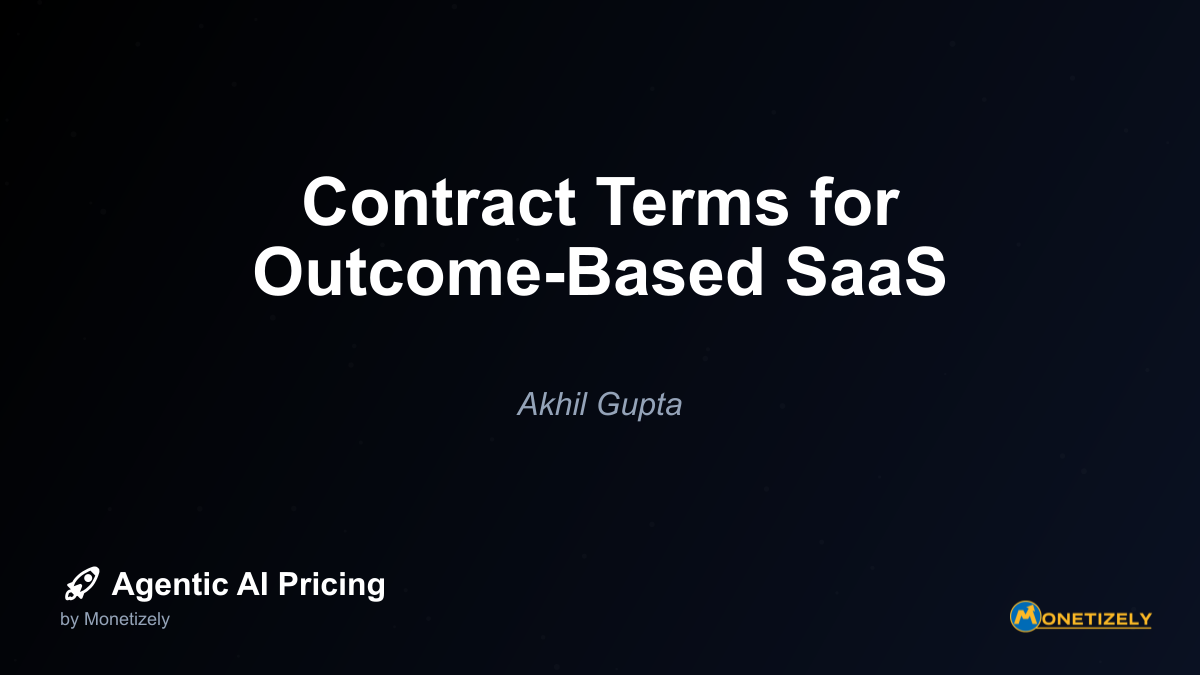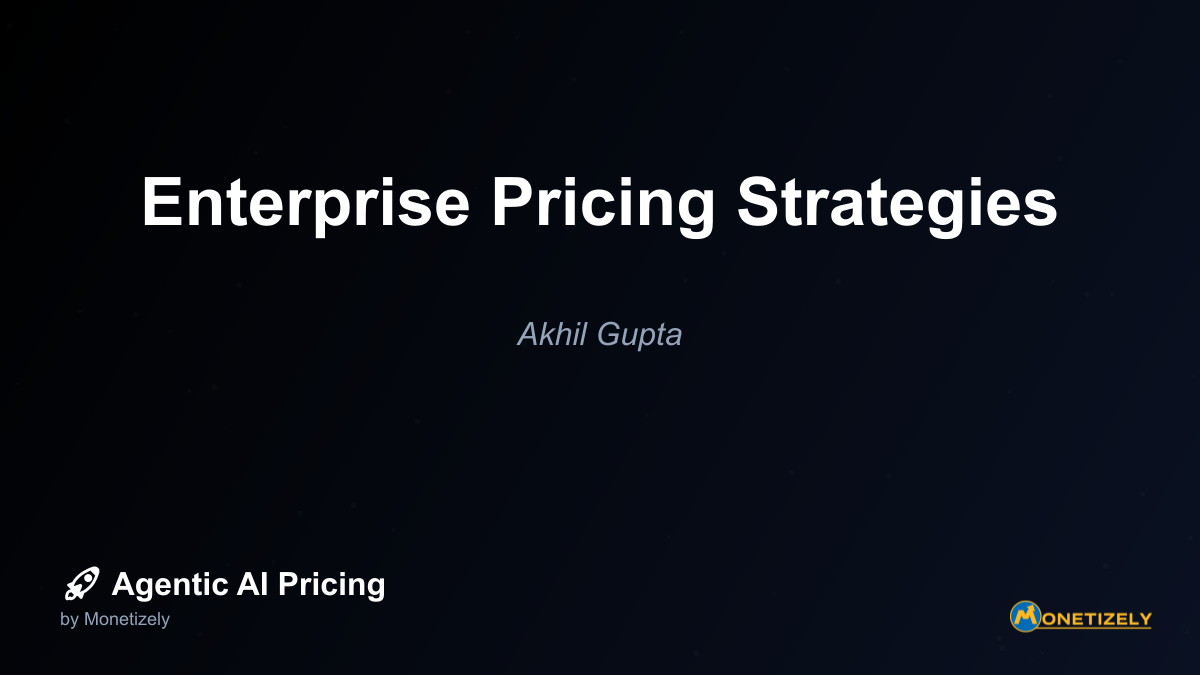· Ajit Ghuman · Pricing Agentic SaaS Products · 9 min read
Seasonal Pricing in Agentic SaaS
AI and SaaS Pricing Masterclass
Learn the art of strategic pricing directly from industry experts. Our comprehensive course provides frameworks and methodologies for optimizing your pricing strategy in the evolving AI landscape. Earn a professional certification that can be imported directly to your LinkedIn profile.

3. Dynamic Pricing Models for Agentic SaaS
Dynamic pricing takes seasonal strategies a step further by implementing real-time price adjustments based on current market conditions. For agentic solutions, this approach is particularly powerful as it mirrors the adaptive nature of the technology itself.
As explored in Dynamic Pricing Algorithms: Can Real-Time Price Adjustments Work in SaaS?, these models can include:
- Demand-based pricing: Adjusting rates based on current system load and market demand
- Value-based dynamic pricing: Tying costs to measurable business outcomes that fluctuate seasonally
- Predictive pricing models: Using AI to forecast seasonal patterns and proactively adjust pricing
For instance, an agentic sales assistant might implement higher per-transaction fees during peak selling seasons when each sale generates more revenue, and lower fees during slower periods to maintain affordability.
4. Capacity Reservation Models
Some seasonal businesses need guaranteed agent availability during critical high-demand periods. Capacity reservation models address this need:
- Reserved capacity plans: Customers pay a base fee to ensure agent availability during peak seasons
- Burst capacity pricing: Predetermined rates for exceeding normal usage limits during seasonal spikes
- Priority service tiers: Ensuring critical seasonal operations receive preferential resource allocation
A retail inventory management agent might offer capacity reservation plans that guarantee sufficient processing power to handle Black Friday transaction volumes without performance degradation.
Implementation Strategies for Seasonal Agentic SaaS Pricing
Successfully implementing seasonal pricing requires careful planning and execution. Consider these practical approaches:
1. Data-Driven Seasonal Analysis
Before implementing any seasonal pricing strategy, thorough analysis is essential:
- Historical usage patterns: Analyze multiple years of data to identify consistent seasonal trends
- Industry-specific benchmarks: Research how seasonality affects your customers’ industries
- Agent utilization metrics: Understand how seasonal fluctuations impact specific agent functions
- Customer segmentation analysis: Identify which customer segments exhibit the strongest seasonal patterns
For example, an agentic marketing automation platform might analyze three years of campaign data to identify that B2C retailers increase email volume by 300% in Q4, while B2B technology companies show minimal seasonal variation.
2. Transparent Communication and Education
Seasonal pricing models require clear communication to avoid customer confusion or frustration:
- Proactive seasonal planning guides: Help customers anticipate and budget for seasonal changes
- Usage dashboards with predictive analytics: Show customers their historical patterns and projected needs
- ROI calculators: Demonstrate how seasonal pricing aligns with their business value cycles
- Educational content: Explain how the agentic system adapts to their seasonal needs
An agentic customer service solution might provide seasonal planning guides showing how conversation volumes typically fluctuate throughout the year for different industry segments, helping customers select appropriate seasonal plans.
3. Flexible Contract Structures
Contract terms should accommodate seasonal realities:
- Rolling commitment periods: Allow contract renewals to align with seasonal business cycles
- Seasonal amendment provisions: Streamline the process for temporary capacity adjustments
- Auto-scaling clauses: Define parameters for automatic seasonal adjustments within agreed boundaries
- Seasonal payment terms: Align payment timing with customer cash flow patterns
For instance, a retail-focused agentic solution might offer contracts beginning in February (after holiday season) with payment terms that require lower monthly fees during slow periods and higher fees during peak seasons.
4. Technical Implementation Considerations
The backend systems supporting seasonal pricing must be robust:
- Usage monitoring infrastructure: Systems that accurately track the metrics driving seasonal pricing
- Automated scaling mechanisms: Technical capacity to expand and contract agent resources as needed
- Billing system flexibility: Capability to handle variable pricing periods and complex seasonal rules
- Forecasting algorithms: Predictive capabilities to anticipate seasonal demand patterns
An agentic content management system might implement sophisticated monitoring tools that track not just API calls but also the complexity and resource requirements of content being processed seasonally.
Case Studies: Successful Seasonal Pricing for Agentic SaaS
Retail Inventory Management Agent
Challenge: A retail inventory management agent faced extreme usage variations, with some customers experiencing 500% increases in transaction volume during Q4 holiday seasons.
Solution: Implemented a hybrid pricing model with:
- Base subscription covering “normal” operations (70% of peak capacity)
- Pre-purchased seasonal capacity packages available quarterly
- Dynamic surge pricing for unexpected demand spikes
- Seasonal payment distribution allowing customers to spread Q4 costs across the year
Results:
- 35% increase in customer retention
- 28% growth in annual revenue per customer
- Reduced support tickets related to seasonal performance issues
- Improved customer satisfaction scores during peak seasons
Agricultural Decision Support Agent
Challenge: An agricultural AI agent experienced extreme seasonal usage patterns tied to growing seasons, with minimal usage during winter months in temperate regions.
Solution: Created a “seasonal hibernation” model:
- Full-featured growing season subscription (region-specific timing)
- Reduced-cost hibernation mode maintaining data and allowing planning functions
- Multi-year contracts with seasonally-adjusted payment schedules
- Global customer base across different hemispheres to balance seasonal demand
Results:
- Reduced off-season churn by 64%
- Increased multi-year contract adoption by 42%
- More predictable revenue throughout the year
- Expanded global market share by accommodating different regional growing seasons
Seasonal Tourism Marketing Agent
Challenge: A tourism marketing agent served destinations with opposing peak seasons (winter ski resorts vs. summer beach destinations) and needed to balance resource allocation.
Solution: Developed a “seasonal transfer” model:
- Destination-specific pricing tiers based on their unique seasonal patterns
- Credit system allowing unused off-season capacity to transfer to other destinations
- Marketplace for trading seasonal capacity among customer organizations
- Industry-specific benchmarking tools showing seasonal performance metrics
Results:
- Created a balanced resource utilization pattern across the year
- Generated new revenue stream from the capacity marketplace
- Increased cross-destination referrals and partnerships
- Improved agent performance through more consistent training data across seasons
Measuring the Success of Seasonal Pricing Strategies
Implementing seasonal pricing requires ongoing measurement and refinement. Key metrics to track include:
Financial Metrics
- Seasonally-adjusted customer lifetime value (SCLV): Measures customer value accounting for predictable seasonal patterns
- Revenue stability index: Evaluates how effectively your pricing smooths seasonal revenue fluctuations
- Seasonal cost-to-serve ratio: Tracks how efficiently you manage resources across seasonal peaks and valleys
- Seasonal discount efficiency: Measures the revenue impact of seasonal promotions or pricing adjustments
Customer Metrics
- Seasonal retention patterns: Identifies whether churn correlates with seasonal transitions
- Cross-seasonal engagement: Measures how consistently customers utilize the agent throughout the year
- Seasonal satisfaction variation: Tracks customer satisfaction across different seasonal periods
- Seasonal upgrade/downgrade rates: Monitors how frequently customers change tiers based on seasonal needs
Operational Metrics
- Seasonal resource utilization: Evaluates how efficiently agent resources are allocated across seasons
- Forecast accuracy: Measures how well you predict seasonal demand patterns
- Seasonal support volume: Tracks how support requirements fluctuate with seasonal pricing changes
- Seasonal feature usage: Identifies which agent capabilities see usage spikes during different seasons
Common Pitfalls in Seasonal Agentic SaaS Pricing
While implementing seasonal pricing strategies, watch for these common challenges:
1. Oversimplifying Seasonal Patterns
Seasonal patterns are rarely as simple as they first appear. Many businesses experience:
- Micro-seasons: Shorter periods of high or low demand within broader seasonal patterns
- Overlapping seasonality: Multiple seasonal factors affecting demand simultaneously
- Evolving patterns: Seasonal trends that shift gradually over time
- Anomalous events: One-time occurrences that can be mistaken for seasonal patterns
For agentic SaaS, this complexity requires sophisticated analysis and flexible pricing models that can adapt to nuanced patterns rather than simple high/low season divisions.
2. Neglecting the Global Perspective
For global agentic SaaS providers, seasonal patterns vary significantly by region:
- Hemisphere differences: Opposite seasons in northern and southern hemispheres
- Cultural and religious calendars: Different holiday periods across cultures
- Fiscal year variations: Different financial planning cycles by country
- Regional industry differences: Industry-specific seasonal patterns that vary geographically
A globally available agentic solution must consider these variations in its seasonal pricing strategy, potentially implementing region-specific approaches.
3. Creating Excessive Complexity
While addressing seasonal patterns is important, overly complex pricing can confuse customers:
- Too many seasonal tiers: Creating excessive pricing variations throughout the year
- Complicated discount structures: Seasonal promotions that are difficult to understand
- Unpredictable adjustments: Frequent or poorly communicated seasonal changes
- Administrative burden: Seasonal changes requiring significant customer effort
The goal should be pricing that adapts to seasonal patterns while remaining transparent and manageable for customers.
4. Misaligning with Customer Budgeting Cycles
Many organizations plan and allocate budgets annually, creating friction with seasonal pricing:
- Budget approval misalignment: Seasonal changes occurring mid-budget period
- Forecasting challenges: Difficulty predicting total annual costs with variable pricing
- Procurement process conflicts: Organizational purchasing processes that struggle with variable costs
- Internal justification issues: Challenges explaining cost variations to internal stakeholders
Successful seasonal pricing strategies must consider these organizational realities and provide tools to help customers manage budgetary processes.
The Future of Seasonal Pricing for Agentic SaaS
As agentic AI continues to evolve, we can anticipate several emerging trends in seasonal pricing:
1. AI-Driven Personalized Seasonal Pricing
Future agentic solutions will likely implement increasingly sophisticated personalization:
- Custom seasonal profiles: AI-generated seasonal pricing patterns unique to each customer
- Predictive usage modeling: Anticipating individual customer’s seasonal needs before they do
- Automated optimization: Continuously refining seasonal pricing parameters based on outcomes
- Cross-product seasonal integration: Coordinating seasonal pricing across multiple agentic tools
These approaches will move beyond broad seasonal categories toward truly individualized pricing that reflects each organization’s unique patterns.
2. Ecosystem-Based Seasonal Pricing
As agentic solutions become more interconnected, pricing will increasingly reflect ecosystem dynamics:
- Supply chain synchronization: Pricing that adapts to seasonal patterns across entire supply chains
- Industry-wide coordination: Seasonal pricing aligned with broader industry cycles
- Partner network optimization: Pricing that accounts for seasonal patterns across partner ecosystems
- Cross-platform resource balancing: Sharing seasonal capacity across multiple agentic platforms
This ecosystem perspective will help optimize resource allocation and value delivery across interconnected business networks.
3. Climate-Adaptive Seasonal Pricing
As climate change alters traditional seasonal patterns, pricing strategies will need to adapt:
- Weather-responsive pricing: Dynamic adjustments based on actual conditions rather than calendar dates
- Climate trend integration: Pricing that evolves with changing long-term climate patterns
- Disaster-responsive flexibility: Special provisions for climate-related disruptions
- Sustainability incentives: Seasonal pricing that encourages environmentally responsible usage patterns
These approaches acknowledge that traditional seasonal calendars may become less reliable guides for business patterns in the future.
Conclusion: Building a Resilient Seasonal Pricing Strategy
Effective seasonal pricing for agentic SaaS requires balancing flexibility with predictability and complexity with usability. By understanding your customers’ seasonal patterns, implementing appropriate pricing models, and continuously measuring and refining your approach, you can create a pricing strategy that accommodates seasonal fluctuations while delivering consistent value.
For businesses serving seasonally-affected industries, this approach isn’t merely a pricing tactic—it’s a fundamental business strategy that aligns your revenue model with your customers’ business realities. When implemented effectively, seasonal pricing can transform challenging cyclical patterns from a threat to an opportunity, creating stronger customer relationships and more sustainable revenue streams.
As you develop your seasonal pricing strategy for agentic SaaS products, remember that the goal isn’t to maximize revenue during peak periods, but rather to create a sustainable relationship that delivers appropriate value throughout the entire business cycle. By aligning your pricing with your customers’ seasonal realities, you position your agentic solution as a true business partner rather than just another expense—a distinction that drives long-term loyalty in an increasingly competitive market.
For more detailed guidance on implementing and testing seasonal pricing strategies, explore How to Test Seasonal SaaS Pricing Variations: A Strategic Approach.
Co-Founder & CEO
Ajit is the author of Price To Scale, a top book on SaaS Pricing and is the Founder of Monetizely. Ajit has led and worked in pricing and product marketing at firms like Twilio, Narvar and Medallia. His work has been featured in Forbes and VentureBeat. Ajit regularly consults with software companies from Seed stage to post-IPO on pricing strategy. Ajit is also a highly-rated co-instructor for 'The Art of SaaS Pricing and Monetization' on Maven.
Pricing Strategy Audit
Let our experts analyze your current pricing strategy and identify opportunities for improvement. Our data-driven assessment will help you unlock untapped revenue potential and optimize your AI pricing approach.




